Borgund Stave Church
Borgund Stave Church (Norwegian: Borgund stavkyrkje) is a former parish church of the Church of Norway in Lærdal Municipality in Vestland county, Norway. The old stave church is located in the village of Borgund. It was the church for the Lærdal parish (which is part of the Sogn prosti (deanery) in the Diocese of Bjørgvin) until 1868 when it was closed and turned into a museum. The brown, wooden church was built in a stave church style around the year 1200. It is classified as a triple-nave stave church of the Sogn-type. No longer regularly used for church functions, it is now a museum run by the Society for the Preservation of Ancient Norwegian Monuments. It was replaced by the "new" Borgund Church in 1868.[1][2]
| Borgund Stave Church | |
|---|---|
| Borgund stavkyrkje | |
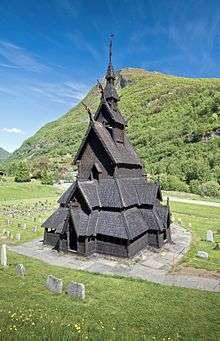 View of the church | |
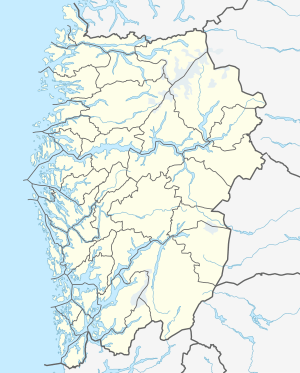 Borgund Stave Church Location of the church 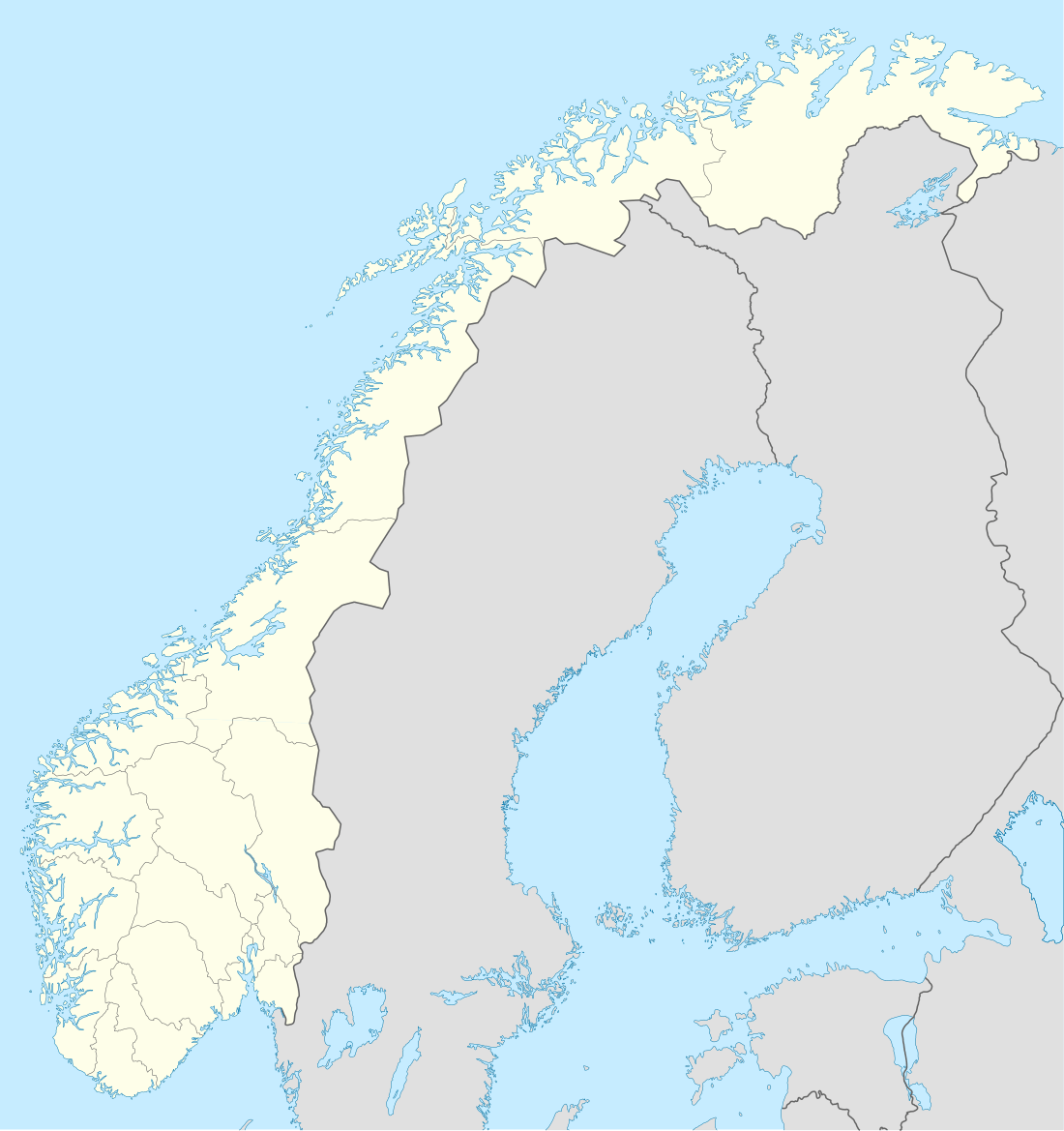 Borgund Stave Church Borgund Stave Church (Norway) | |
| 61.0472°N 07.8122°E | |
| Location | Lærdal Municipality, Vestland |
| Country | Norway |
| Denomination | Church of Norway |
| Churchmanship | Evangelical Lutheran |
| Website | www |
| History | |
| Status | Former parish church |
| Founded | c. 1200 |
| Architecture | |
| Functional status | Museum |
| Architect(s) | Unknown |
| Architectural type | Stave church |
| Completed | c. 1200 |
| Closed | 1868 |
| Specifications | |
| Materials | Wood |
| Administration | |
| Parish | Lærdal |
| Deanery | Sogn prosti |
| Diocese | Bjørgvin |
| Type | Church |
| Status | Automatically listed |
| ID | 83933 |
Construction

Borgund Stave Church was built sometime between 1180 and 1250 AD with later additions and restorations. Its walls are formed by vertical wooden boards, or staves, hence the name "stave church." The four corner posts are connected to one another by ground sills, resting on a stone foundation.[3] The intervening staves rise from the ground sills; each is tongued and grooved, to interlock with its neighbours and form a sturdy wall.[4]
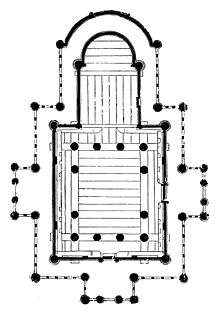
Borgund is built on a basilica plan, with reduced side aisles, and an added chancel and apse.[5] It has a raised central nave demarcated on four sides by an arcade. An ambulatory runs around this platform and into the chancel and apse, both added in the 14th century. An additional ambulatory, in the form of a porch, runs around the exterior of the building, sheltered under the overhanging shingled roof. The floor plan of this church resembles that of a central plan, double-shelled Greek cross with an apse attached to one end in place of the fourth arm. The entries to the church are in the three arms of the almost-cross.
Structurally, the building has been described as a "cube within a cube", each independent of the other. The inner "cube" is formed by continuous columns that rise from ground level to support the roof. The top of the arcade is formed by arched buttresses, knee jointed to the columns. Above the arcade, the columns are linked by cross-shaped, diagonal trusses, commonly dubbed "Saint Andrew's crosses"; these carry arched supports that offer the visual equivalent of a "second story". While not a functional gallery, this is reminiscent of contemporary second story galleries of large stone churches elsewhere in Europe. Smaller beams running between these upper supporting columns help clamp everything firmly together. The weight of the roof is thus supported by buttresses and columns, preventing downward and outward thrust on the stave walls.[6][7]
The roof beams are supported by steeply angled scissor trusses that form an X shape with a narrow top span and a broader bottom span, tied by a bottom truss to prevent collapse. Additional support is given by a truss that cuts across the X, below the crossing point but above the bottom truss. The roof is steeply pitched, boarded horizontally and clad with shingles. The original outer roof would have been weatherproofed with boards laid lengthwise, rather than shingles. In later years wooden shingles became more common.[8] Scissor beam roof construction is typical of most stave churches.[9]
Borgund has tiered, overhanging roofs, topped with a tower. On the gables of the roof, there are four carved dragon heads, swooping from the carved roof ridge crests,[10] recalling the carved dragon heads found on the prows of Norse ships. Similar gable heads also appear on small bronze house shaped reliquaries common in Norway in this period.[10] Borgund's current dragon heads possibly date from the 18th century,[10] however original dragon heads remaining on earlier structures, such as Lom Stave Church and nearby Urnes Stave Church, the oldest still extant stave church, also in the Sogn district, suggest that there probably would have been similar dragon heads there at one time.[11] Borgund is one of the only churches to still have preserved its ridge crests, carved with openwork vine and vegetal repeating designs.[10] The dragons on top of the church were often used as a form of drainage.


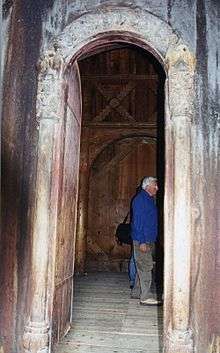
Most of the internal fittings have been removed. There is little in the building, apart from the row of benches that are installed along the wall inside the church in the ambulatory outside of the arcade and raised platform, a soapstone font, an altar (with 17th-century altarpiece), a 16th-century lectern, and a 16th-century cupboard for storing altar vessels. After the Reformation, when the church was converted for Protestant worship, pews, a pulpit and other standard church furnishings were included, however these have been removed since the building has come under the protection of the Fortidsminneforeningen (The Society for the Preservation of Norwegian Ancient Monuments). There would have been more artwork in the building, most likely in the form of statues and crucifixes, as remain in a few other churches, but these are now lost.
Runic inscriptions
Several runic inscriptions are found on the walls of the Church's west portal. One reads: Thor wrote these runes in the evening at the St. Olav's Mass. Another reads "Ave Maria".
Management
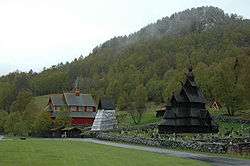
A new Borgund Church was built in 1868 right next to the old church, and the old church has not been in ordinary use since that year. Borgund Stave Church was bought by the Society for the Preservation of Ancient Norwegian Monuments in 1877. The first guidebook in English for the stave church was published in 1898.
Legacy
The church served as the inspiring example for the reconstruction of the Fantoft Stave Church in Fana, Bergen, in 1883 and for its rebuilding in 1997. The Gustav Adolf Stave Church in Hahnenklee, Germany, built in 1908, is modeled on the Borgund church. Three replicas exist in the United States, one at Chapel in the Hills, Rapid City, South Dakota.,[12] another in Lyme, Connecticut.,[13] and the third on Washington Island, Wisconsin[14]
See also
- List of churches in Bjørgvin
- Runic inscription N 351
- Washington Island Stavkirke (Modeled after The Borgund Stave Church)
References
- "Borgund stavkyrkje". Kirkesøk: Kirkebyggdatabasen. Retrieved 2020-01-17.
- "Oversikt over Nåværende Kirker" (in Norwegian). KirkeKonsulenten.no. Retrieved 2020-01-17.
- "Borgund Stave Church". Fortidsminneforeningen (The Society for the Preservation of Norwegian Ancient Monuments). Archived from the original on 17 September 2011. Retrieved 1 November 2011.
- Hauglid (1970), p. 99.
- Hauglid (1970), p. 32.
- Hauglid (1970), p. 104.
- Sheldon, Gwendolyn, “The Origin of the Norwegian Stave Church” at the Third Annual North American Interdisciplinary Conference on Medieval Icelandic Studies, Cornell University, May 2008, pp. 3–4
- Hauglid (1970), p. 12.
- Hauglid (1970)
- Hohler (1999), p. 69.
- Hauglid (1970), p. 13
- "History of the Chapel in the Hills". Chapel in the Hills. Retrieved February 27, 2018.
- "Borgund Stave Church replica Lyme Connecticut". Retrieved March 13, 2018.
- https://washingtonisland.com/stavkirke/
Bibliography
- Hauglid, Roar; trans. R. I. Christophersen (1970). Norwegian Stave Churches. Oslo: Dreyers Forlag.
- Hohler, Erla Bergendahl (1999). Norwegian Stave Church Sculpture. I. Oslo: Scandinavian University Press. ISBN 978-82-00-12748-2.
External links
| Wikimedia Commons has media related to Borgund stavkirke. |
- Borgund stave church in Stavkirke.org (in Norwegian)
- Borgund stave church in Fortidsminneforeningen
- Fortidsminneforeninga's stave church pages (in Norwegian) (there are also English and German pages)
- Replica in Rapid City
- Information about Borgund stave church (in English)

